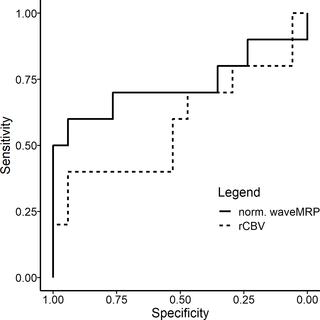Our official English website, www.x-mol.net, welcomes your feedback! (Note: you will need to create a separate account there.)
The wavelet power spectrum of perfusion weighted MRI correlates with tumor vascularity in biopsy-proven glioblastoma samples.
PLOS ONE ( IF 3.7 ) Pub Date : 2020-01-23 , DOI: 10.1371/journal.pone.0228030 Lukas T Rotkopf 1 , Benedikt Wiestler 1 , Christine Preibisch 1 , Friederike Liesche-Starnecker 2 , Thomas Pyka 1 , Dominik Nörenberg 3 , Stefanie Bette 4 , Jens Gempt 5 , Kolja M Thierfelder 6 , Claus Zimmer 1 , Thomas Huber 3
PLOS ONE ( IF 3.7 ) Pub Date : 2020-01-23 , DOI: 10.1371/journal.pone.0228030 Lukas T Rotkopf 1 , Benedikt Wiestler 1 , Christine Preibisch 1 , Friederike Liesche-Starnecker 2 , Thomas Pyka 1 , Dominik Nörenberg 3 , Stefanie Bette 4 , Jens Gempt 5 , Kolja M Thierfelder 6 , Claus Zimmer 1 , Thomas Huber 3
Affiliation

|
BACKGROUND
Wavelet transformed reconstructions of dynamic susceptibility contrast (DSC) MR perfusion (wavelet-MRP) are a new and elegant way of visualizing vascularization. Wavelet-MRP maps yield a clear depiction of hypervascular tumor regions, as recently shown.
OBJECTIVE
The aim of this study was to elucidate a possible connection of the wavelet-MRP power spectrum in glioblastoma (GBM) with local vascularity and cell proliferation.
METHODS
For this IRB-approved study 12 patients (63.0+/-14.9y; 7m) with histologically confirmed IDH-wildtype GBM were included. Target regions for biopsies were prospectively marked on tumor regions as seen on preoperative 3T MRI. During subsequent neurosurgical tumor resection 43 targeted biopsies were taken from these target regions, of which all 27 matching samples were analyzed. All specimens were immunohistochemically analyzed for endothelial cell marker CD31 and proliferation marker Ki67 and correlated to the wavelet-MRP power spectrum as derived from DSC perfusion weighted imaging.
RESULTS
There was a strong correlation between wavelet-MRP power spectrum (median = 4.41) and conventional relative cerebral blood volume (median = 5.97 ml/100g) in Spearman's rank-order correlation (κ = .83, p < .05). In a logistic regression model, the wavelet-MRP power spectrum showed a significant correlation to CD31 dichotomized to no or present staining (p = .04), while rCBV did not show a significant correlation to CD31 (p = .30). No significant association between Ki67 and rCBV or wavelet-MRP was found (p = .62 and p = .70, respectively).
CONCLUSION
The wavelet-MRP power spectrum derived from existing DSC-MRI data might be a promising new surrogate for tumor vascularity in GBM.
中文翻译:

在活检证实的胶质母细胞瘤样品中,加权MRI的小波功率谱与肿瘤血管相关。
背景技术动态敏感性对比(DSC)MR灌注的小波变换重建(小波MRP)是可视化血管形成的一种新的且优雅的方法。如最近所示,小波-MRP图可清晰显示血管过度肿瘤区域。目的本研究的目的是阐明胶质母细胞瘤(GBM)中小波-MRP功率谱与局部血管和细胞增殖的可能联系。方法在该IRB批准的研究中,纳入了12例经组织学确认为IDH野生型GBM的患者(63.0 +/- 14.9y; 7m)。如术前3T MRI所示,活检的目标区域已在肿瘤区域上进行了前瞻性标记。在随后的神经外科肿瘤切除术中,从这些靶区域中采集了43例活检标本,分析了全部27个匹配样本。对所有标本进行了免疫组织化学分析,以分析内皮细胞标记物CD31和增殖标记物Ki67,并与从DSC灌注加权成像得出的小波MRP功率谱相关。结果小波-MRP功率谱(中位数= 4.41)与常规相对脑血容量(中位数= 5.97 ml / 100g)之间的相关性与Spearman等级相关性很强(κ= .83,p <.05)。在对数回归模型中,小波-MRP功率谱显示与CD31二分(无染色或无染色)显着相关(p = .04),而rCBV与CD31没有显着相关(p = .30)。在Ki67与rCBV或小波MRP之间未发现显着关联(分别为p = 0.62和p = .70)。
更新日期:2020-01-24
中文翻译:

在活检证实的胶质母细胞瘤样品中,加权MRI的小波功率谱与肿瘤血管相关。
背景技术动态敏感性对比(DSC)MR灌注的小波变换重建(小波MRP)是可视化血管形成的一种新的且优雅的方法。如最近所示,小波-MRP图可清晰显示血管过度肿瘤区域。目的本研究的目的是阐明胶质母细胞瘤(GBM)中小波-MRP功率谱与局部血管和细胞增殖的可能联系。方法在该IRB批准的研究中,纳入了12例经组织学确认为IDH野生型GBM的患者(63.0 +/- 14.9y; 7m)。如术前3T MRI所示,活检的目标区域已在肿瘤区域上进行了前瞻性标记。在随后的神经外科肿瘤切除术中,从这些靶区域中采集了43例活检标本,分析了全部27个匹配样本。对所有标本进行了免疫组织化学分析,以分析内皮细胞标记物CD31和增殖标记物Ki67,并与从DSC灌注加权成像得出的小波MRP功率谱相关。结果小波-MRP功率谱(中位数= 4.41)与常规相对脑血容量(中位数= 5.97 ml / 100g)之间的相关性与Spearman等级相关性很强(κ= .83,p <.05)。在对数回归模型中,小波-MRP功率谱显示与CD31二分(无染色或无染色)显着相关(p = .04),而rCBV与CD31没有显着相关(p = .30)。在Ki67与rCBV或小波MRP之间未发现显着关联(分别为p = 0.62和p = .70)。



























 京公网安备 11010802027423号
京公网安备 11010802027423号